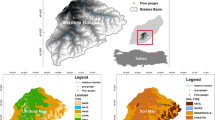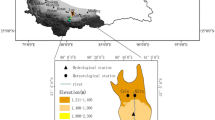Abstract
The real-time availability of several satellite-based precipitation products has recently provided hydrologists with an unprecedented opportunity to improve current hydrologic prediction capability for vast river basins, particularly for ungauged regions. However, the accuracy of real-time satellite precipitation data remains uncertain. This study aims to use three widely used real-time satellite precipitation products, namely, TRMM Multi satellite Precipitation Analysis real-time precipitation product 3B42 (TMPA 3B42RT), Precipitation Estimation from Remote Sensing Information using Artificial Neural Network (PERSIAN), and NOAA/Climate Precipitation Center Morphing Technique (CMORPH), for ensemble stream flow simulation with the gridded xinanjiang (XAJ) model and shuffled complex evolution metropolis (SCEM-UA) algorithm in the middle-latitude Mishui basin in South China. To account the bias of the satellite precipitation data and consider the input uncertainty, two different methods, i.e. a precipitation error multiplier and a precipitation error model were introduced. For each precipitation input model, the posterior probability distribution of the parameters and their associated uncertainty were calibrated using the SCEM-UA algorithm, and 15,000 ensemble stream flow simulations were conducted. The simulations of the satellite precipitation data were then optimally merged using the Bayseian model averaging (BMA) method. The result shows that in Mishui basin, the three sets of real-time satellite precipitation data largely underestimated rainfall. Streamflow simulation performed poorly when the raw satellite precipitation data were taken as input and the model parameters were calibrated with gauged data. By implementing the precipitation error multiplier and the precipitation error model and then recalibrating the model, the behavior of the simulated stream flow and calculated uncertainty boundary were significantly improved. Furthermore, the BMA combination of the simulations from the three datasets resulted in a significantly better prediction with a remarkably reliable uncertainty boundary and was comparable with the simulation using the post-real-time bias-corrected research quality TMPA 3B42V7. The proposed methodology of bias adjustment, uncertainty analysis, and BMA combination collectively facilitates the application of the current three real-time satellite data to hydrological prediction and water resource management over many under-gauged basins. This research is also an investigation on the hydrological utility of multi-satellite precipitation data ensembles, which can potentially integrate additional more satellite products when the Global Precipitation Measuring mission with 9-satellite constellation is anticipated in 2014.








Similar content being viewed by others
References
Ajami NK, Duan QY, Sorooshian S (2007) An Integrated Hydrological Bayesian Multimodel Combination Framework: Confronting Input, Parameter, and Model Structural Uncertainty in Hydrologic Prediction. Water Resour Res 43, W01403
Bartier PM, Keller CP (1996) Multivariate Interpolation to Incorporate Thematic Surface Data Using Inverse Distance Weighting (IDW). Comput Geosci 22:795–799
Behrangi A, Khakbaz B, Jaw TC, AghaKouchak A, Hus K, Sorooshian S (2011) Hydrologic Evaluation of Satellite Precipitation Products Over a mid-Size Basin. J Hydrol 397(3–4):225–237
Bitew MM, Gebremichael M (2011) Evaluation of Satellite Rainfall Products Through Hydrologic Simulation in a Full Distributed Hydrologic Model. Water Resour Res 47, W06526
Duan QY, Sorooshian S, Gupta VK (1994) Optimal use of the SCE-UA Global Optimization Method for Calibrating Watershed Models. J Hydrol 158(3–4):265–284
Duan QY, Ajami NK, Gao XG, Sorooshian S (2007) Multi-Model Ensemble Hydrologic Prediction Using Bayesian Model Averaging. Adv Water Resour 30(5):1371–1386
Gottschalck J, Meng J, Rodell M, Houser P (2005) Analysis of Multiple Precipitation Products and Preliminary Assessment of Their Impact on Global Land Data Assimilation System Land Surface States. J Hydrometeorol 6(5):573–598
Gebregiorgis A, Hossain F (2011) How Much Can A Priori Hydrologic Model Predictability Help in Optimal Merging of Satellite Precipitation Products? J Hydrometeorol 12:1287–1298
Hong Y, Hsu KL, Soroosh S, Gao XG (2004) Precipitation Estimation from Remotely Sensed Imagery Using Artificial Neural Network – Cloud Classification System (PERSIANN-CCS). J Appl Meteorol 43(12):1834–1853
Hong Y, Hsu KL, Moradkhani H, Soroosh S (2006) Uncertainty Quantification of Satellite Precipitation Estimation and Monte Carlo Assessment of the Error Propagation into Hydrologic Response. Water Resour Res 42, W08421
Huffman GJ, Adler RF, Bolvin DT, Gu GJ, Nelkin EJ, Bowman KP, Hong Y, Stocker EF, Wolff DB (2007) The TRMM Multi-Satellite Precipitation Analysis (TMPA): Quasi-Global, Multi-Year, Combined-Sensor Precipitation Estimates at Fine Scales. J Hydrometeorol 8(1):38–55
Joyce RJ, Janowiak JE, Arkin PA, Xie PP (2004) CMORPH: A Method That Produces Global Precipitation Estimates from Passive Microwave and Infrared Data at High Spatial and Temporal Resolution. J Hydrometeorol 5(3):487–503
Jiang SH, Ren LL, Yong B, Yang XL, Shi L (2010) Evaluation of High-Resolution Satellite Precipitation Products With Surface Rain Gauge Observations from Laohahe Basin in Northern China. Water Sci Eng 3(4):405–417
Jiang SH, Ren LL, Hong Y, Yong B, Yang XL, Yuan F, Ma MW (2012) Comprehensive Evaluation of Multi-Satellite Precipitation Products With a Dense Rain Gauge Network and Optimally Merging Their Simulated Hydrological Flows Using the Bayesian Model Averaging Method. J Hydrol 452–453:213–225
Kubota T, Shige S, Hashizume H, Aonashi K, Takahashi N, Seto S, Takayabu YN, Ushio T, Nakagawa K, Iwanami K, Kachi M, Okamoto K (2007) Global Precipitation map Using Satellite Borne Microwave Radiometers by the GSMaP Project: Production and Validation. IEEE Trans Geosci Remote Sens 45:2259–2275
Kidd C, Huffman G (2011) Global Precipitation Measurement. Meteorol Appl 18(3):334–353
Kwon HH, Filho FAS, Block P, Sun LQ, Lall U, Jr DSR (2012) Uncertainty Assessment of Hydrologic and Climate Forecast Models in Northeastern Brazil. Hydrol Process 26(25):3875–3885
Kucera PA, Ebert EE, Turk FJ, Levizzani V, Kirschbaum D, Tapiador FJ, Loew A, Borsche M (2013) Precipitation from Space: Advancing Earth System Science. Bull Am Meteorol Soc 94(3):365–375
Li Z, Yang DW, Hong Y (2013) Multi-Scale Evaluation of High-Resolution Multi-Sensor Blended Global Precipitation Products Over the Yangtze River. J Hydrol 500:157–169
Raftery AE, Balabdaoui F, Polakowski M, Polakowski M (2005) Using Bayesian Model Averaging to Calibrate Forecast Ensembles. Mon Weather Rev 113(5):1155–1174
Sorooshian S, Hsu KL, Gao XG, Gupta HV, Imam B, Braithwaite D (2000) Evaluation of PERSIANN System Satellite-Based Estimates of Tropical Rainfall. Bull Am Meteorol Soc 81:2035–2046
Su FG, Hong Y, Lettenmaier DP (2008) Evaluation of TRMM Multi-Satellite Precipitation Analysis (TMPA) and its Utility in Hydrologic Prediction in La Plata Basin. J Hydrometeorol 9(4):622–640
Stisen S, Sandholt I (2010) Evaluation of Remote-Sensing-Based Rainfall Products Through Predictive Capability in Hydrological Runoff Modeling. Hydrol Process 24(7):879–891
Strauch M, Bernhofer C, Koide S, Volk M, Lorz C, Makeschin F (2012) Using Precipitation Data Ensemble for Uncertainty Analysis in SWAT Streamflow Simulation. J Hydrol 414–415:413–424
Vrugt JA, Gupta HV, Bouten W, Sorooshian S (2003) A Shuffled Complex Evolution Metropolis Algorithm for Optimization and Uncertainty Assessment of Hydrologic Model Parameters. Water Resour Res 39:1201
Xiong LH, Wan M, Wei XJ, Connor KM (2009) Indices for Assessing the Prediction Bounds of Hydrological Models and Application by Generalized Likelihood Uncertainty Estimation. Hydrol Sci J 54(5):852–871
Xue XW, Hong Y, Limaye AS, Gourley JJ, Huffman GJ, Shan SI, Dorji C, Chen S (2013) Statistical and Hydrological Evaluation of TRMM-Based Multi-Satellite Precipitation Analysis Over the Wangchu Basin of Bhutan: Are the Latest Satellite Precipitation Products 3B42V7 Ready for use in Ungauged Basins? J Hydrol 499:91–99
Yu MY, Chen X, Li LH, Bao AM, Paix MJ (2011) Streamflow Simulation by SWAT Using Different Precipitation Sources in Large Arid Basins With Scarce Raingauges. Water Resour Manage 25:2669–2681
Yong B, Hong Y, Ren LL, Gourley JJ, Huffman GJ, Chen X, Wang W, Khan SI (2012) Assessment of Evolving TRMM-Based Multi-Satellite Real-Time Precipitation Estimation Methods and Their Impacts on Hydrologic Prediction in a High Latitude Basin. J Geophys Res 117, D09108
Zhao RJ (1992) The Xinanjiang Model Applied in China. J Hydrol 135:371–381
Acknowledgments
The current study was jointly supported by the Programme of Introducing Talents of Discipline to Universities by the Ministry of Education and the State Administration of Foreign Experts Affairs, China (the 111 Project, No. B08048), the Special Basic Research Fund by the Ministry of Science and Technology, China (No. 2011IM011000), the National Science Foundation for Young Scientists of China (No. 41,201,031), and the Fundamental Research Funds for the Central Universities. We also acknowledge the HyDROS Lab (HyDRometeorology and RemOte Sensing Laboratory: http://hydro.ou.edu) at the National Weather Center, Norman, OK for their guidance and support.
Author information
Authors and Affiliations
Corresponding author
Rights and permissions
About this article
Cite this article
Jiang, S., Ren, L., Hong, Y. et al. Improvement of Multi-Satellite Real-Time Precipitation Products for Ensemble Streamflow Simulation in a Middle Latitude Basin in South China. Water Resour Manage 28, 2259–2278 (2014). https://doi.org/10.1007/s11269-014-0612-4
Received:
Accepted:
Published:
Issue Date:
DOI: https://doi.org/10.1007/s11269-014-0612-4




